It all started with an email from Börje Skog in Gothenburg with some blurred mobile phone pictures of a Levin parlor guitar with rosewood at the bottom and side. In addition, with a recessed star in mother-of-pearl at the top of the front of the head, finer mother-of-pearl inlays in the fingerboard and also in the stable. During all these years, I have only seen two other Levin pearls with rosewood at the bottom and side (as well as a lot of mother-of-pearl inlays) and it is Herman Carlsson Levin's own instruments that remain in the Levin family's possession. Unbelievably, Börje is also a neighbor of Göran Levin who has the other two guitars!
Börje did not know much about the guitar. He saved the guitar from an estate of a relative. Asked what he knew and he replied: “I am the only person left from that side of the family. I only know that my grandmother's father had a furniture factory in Berga Småland and started the mission association in Berga. Therefore, I thought he bought it from the religious publisher Youth Star because it was not labeled Levin. Those who could have played on it were dead when I was born in 1946. It has certainly never been used after 1940. Luckily it was still there. "
He wondered what it was worth and I said SEK 10,000. Börje later posted it on Tradera and I could buy it for 10,100 in competition with several others interested. Voted pretty good! Here are some pictures before it was sent.
Took it easy with the guitar before I finally decided to make it my own guitar and not just have it as a beautiful museum piece. It was in both good and bad condition. Admittedly playable with high string height and with a lid without cracks, but both side and bottom had many cracks and even. a fixed-taped loose piece of wood on one side. It needed a renovation and I chose to do it as an Old Gura. Have retained all the parts that were replaced during the renovation.
The guitar is one of the most beautiful Levin I've encountered. Brazilian rosewood in the bottom, side, grip board and stables. Alpine branch in lid and neck in poplar, the typical green-colored wood found in old Levin parlor before 1920 and usually in instruments before 1910. Fine binding on the lid. Fine mother-of-pearl inserts in the grip board as well and the star in the head. Have seen the same star on the head of a double neck mandolin guitar. Is on scene art museum in Stockholm. The unique thing about this guitar is that the white binding on the lid and bottom is in ivory and not white celluloid!
The tuning screws have American dimensions between the posts and have the post below the rack and were in good condition except that a knob was taken. There are matching knobs to buy as the unlabeled tuning screws are not Waverly but by the same manufacturer who later got the name, mounted such a replica. The head is wider than later Levin parlor guitars and is similar to Martin guitars from the same era. I have seen the same main shape on really old Levin parlors, one from 1902 had the same head and I think one from 1905 also had a wider head.
No serial number is stamped on the guitar, but the usual text "Herman Carlsson Levin, Musikinstrumentfabrik, Norra Larmgantan 4, Göteborg". Unusual enough with ink stamp and not burn stamp, moreover on both neck block and on the middle needle at the bottom.
My theory is that this is a very early Levin. Made by Herman himself, either as a fine demonstration copy, a prototype or custom built for a well-off customer. Most likely with material that Herman brought with him from the United States. Rosewood, ivory and American mechanics I have only looked at some finer American guitars from the 1890s when Herman was active as an instrument builder in New York. Ivory has been found on some finer rosewood Bauer guitars, Martin also had ivory in moldings at that time. One Thompson & Odell from the 1890s with rosewood on the side and bottom and which was otherwise almost an exact copy of Levin's parlor guitars, however, had celluloid moldings.
This guitar was clearly built for late strings. The ribbing inside was clear and the neck angle steeper than it would have been with steel strings. Poppel is a soft wood. I think Levin's parlor guitars with poplar are built for late strings while those with harder birch / maple neck are meant for steel strings. Those with the light poplar neck are usually the ones who sound the best after a renovation! The grip board was lowered at the sound hole due to the steep angle of the neck to about 3,5 mm at the outermost, while the rest of the grip board above the 12th band was about 5 mm thick.
The grip board was unloaded with the help of heat and two sharpened skillets.
The neck pocket of old Levin parlor guitars before about 1910 is shallower than they were later. With the joint open, it was fairly easy to loosen the neck using a thin knife.
The stable was unloaded in a similar way. During the two round mother-of-pearl mats, a screw was hidden that was attached to the stable plate and small wooden cubes on the inside. Have seen the same construction on an American Wolfram guitar from about 1895. The glue had loosened and the stable was mostly in the screws and had been deformed by the string. Heat the stable flat with the help of a small iron, a piece of aluminum and some forceps.
The big crux was to loosen the bottom with the delicate ivory strip. It may sound brutal, but the only and best method is to cut loose the bottom with a thin saw just above the strip and through the carving on the inside. With an extra thin Japanese saw with 0.1 mm thick blade it was possible to cut loose bottom.




With the bottom loose you have every opportunity to glue and repair, in my case also replace the ribs. In this way you get two pieces of puzzle that match each other. The only thing that can be seen when the bottom is glued is that the side becomes about 0.2 mm less wide and you can see an extra glue joint on the inside just above the bottom. The bond and the joint between the bond and the side / bottom are untouched.
Have not seen reinforcements of the side on any other Levin parlor. They had stopped some of the cracks on one side, but the long crack on the other side also passed the reinforcement. Glue from the gluing of the stable had dripped down to the bottom. Under the tape, a piece of the page was loose.
The neck was level cut and a carbon fiber rod mounted. The poppel neck is light and sounds good, but it does not last for the length of the string. The carbon fiber rod provides the strength needed without making the neck heavier or changing tone. So long I came before letting the guitar rest for a few months.
Back from Uppsala, the cold turned on. Instead of lying in bed, I grabbed the Levin project at my own pace.
Began to make a replica on the stable, wanted to keep the original intact. Went well to the end when I measured the wrong and managed to sand one end of the stall a little too narrow just before I glued it. Blame on the cold! Later made a second replica that got better.
The bottom had some real cracks that were glued together and got mahogany team moldings. The ribs were in good condition, but had been bent in the middle, so it had to be new replicas with a weak bend in the other direction.
The cracks in the side were glued together with a 0,6 mm thick veneer in rosewood as support on the inside. The loose piece side had many cracks in the entire section between the two support ribs inside and got a full piece of veneer. Uses moths with glued 4 mm yoga mat in natural rubber to press the entire surface of the veneer inside even on curved surfaces, moths on the outside in oak.
Looked like the finest spruce for new ribs in the lid and glued the new stable (which was later unloaded and replaced).
Wanted a 16 ″ radius on the fretboard on my playing guitar. The board had that radius at the upper saddle but at the bottom it was almost flat and also thinned to 3,5 mm. My solution was to sand the underside of the fretboard to 3,5 mm and glue an approximately 2,5 mm thick shim in Madagascar rosewood under the entire board with warm skin glue. Then sand the whole board to a 16. Radius. The glued fretboard had the same nice sound as if it had been solid.
The guitar got a K&K mic mounted.
The bottom was glued back.
My throat was glued to my jig. Lived just as I wanted (this time).
Nowadays, I always cut a plate in maple in the bottom of the neck pocket. Otherwise, there is a great risk that the neck will rise with tight strings as the neck presses against the soft spruce in the necklace. Also attaches a screw into the neck foot from the inside as standard on this mount. The neck became stable and did not move much unexpectedly with tight strings.
Banded on with brass bands. Filled the grooves with thin rosewood strips and traced the grip board before the banding. Really unnecessary as most of the tapes were just right and only a few in the middle about 0,5 mm wrong, but still felt good to have it done.
Laying on one lap of alcohol varnish on the bottom and side to hide the cracking, the lid and the neck needed no new varnish. The adjustments for oversaddle liner were unusually small and the grip board did not need to be cut short at the top which I always do otherwise. Am very pleased with the guitar that sounds and plays as well as it is beautiful!
Was just told that it was double-necked with the same star in my head as mine is from 1921 with number 49330. Got the impression that it was from 1897, but that was the year of the patent.
An alternative storytelling for the guitar could thus be that Levin got exclusive material after the 1st World War and built finer models a few years around 1920. Or there were also rich customers after the war who could pay for the exclusive material he brought with him from the US in 1900 Convinced that it was Herman himself who built the guitar, everything is done in the American tradition just like the guitars made in New York in the 1890s. Furthermore, the craftsmanship of this one is much better than the sometimes clumsy Levin parlor guitars of the same era. The only difference is that the neck would have been mahogany and not poplar if it had been manufactured in the US, but the stains are colored to give the neck the appearance of a clear lacquered mahogany neck. The ivory strips are still a mystery, around 1920 they had been replaced by celluloid strips.



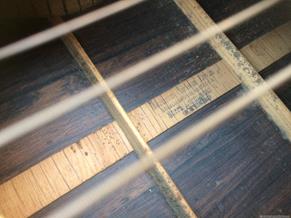


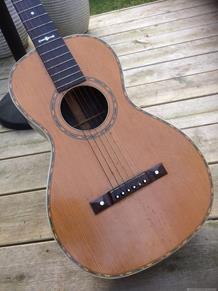


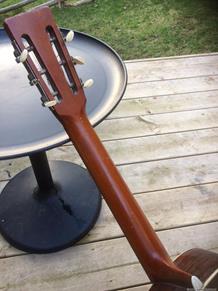
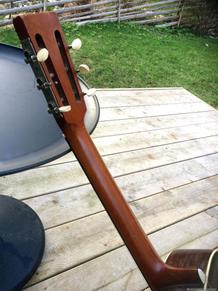




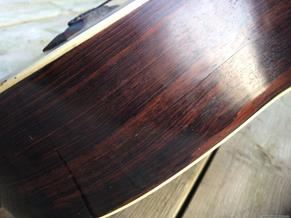




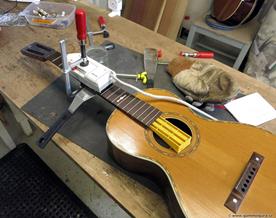

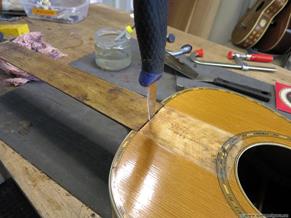














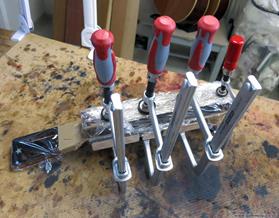


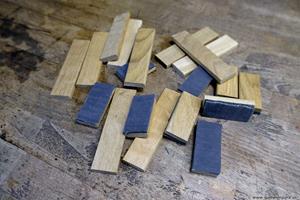



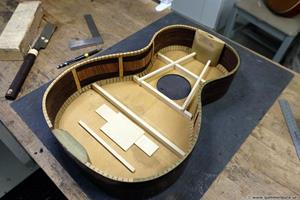






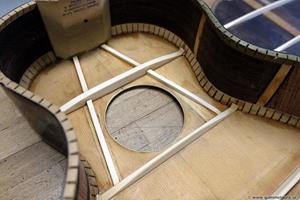

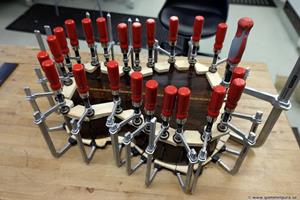
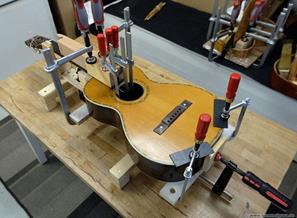
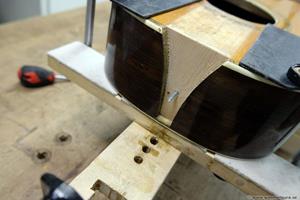



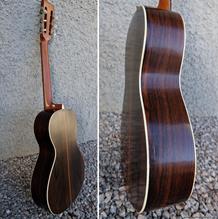
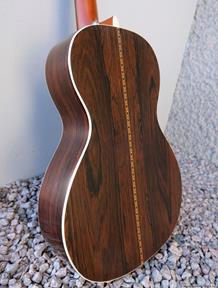
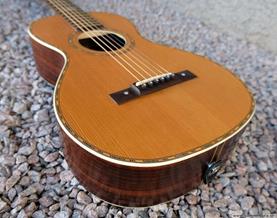

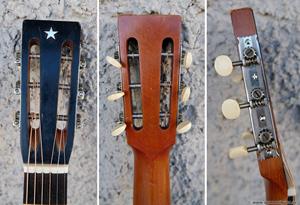
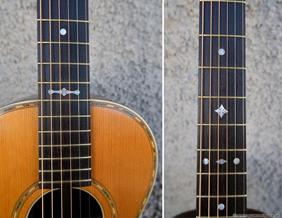


Thank you for telling me about the fate of the guitar.
The piece that was taped was What I made sure to save when I discovered it many years ago I remember.
Sincerely. Borje
Thank you for saving the guitar, good that you taped the piece that was loose!
Thanks for a nice and instructive story. Will probably steal some ideas for my own projects what it is suffering :-)
Please and steal! 😉